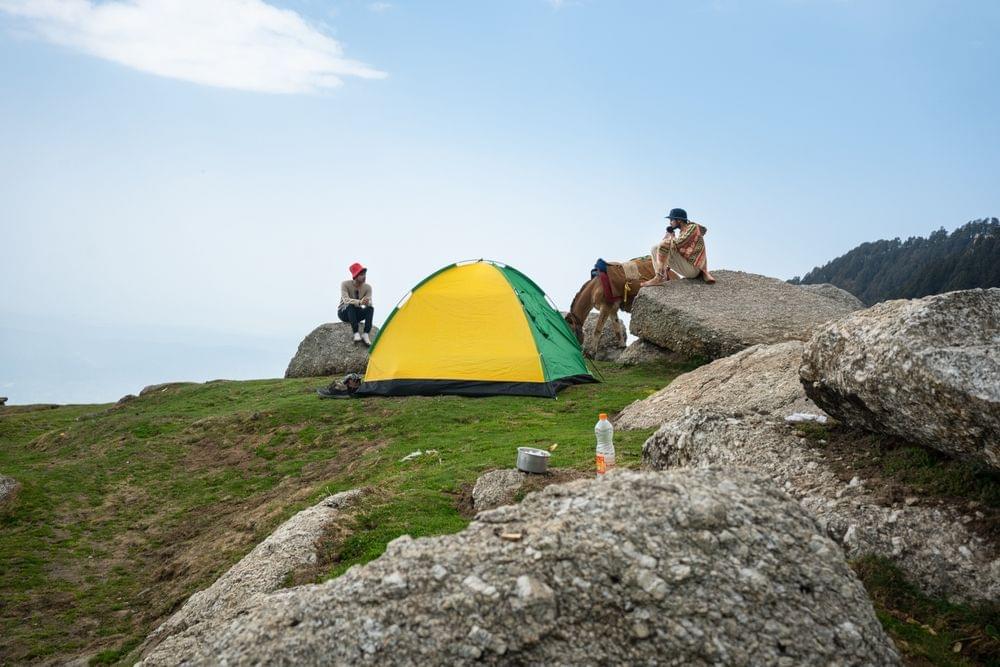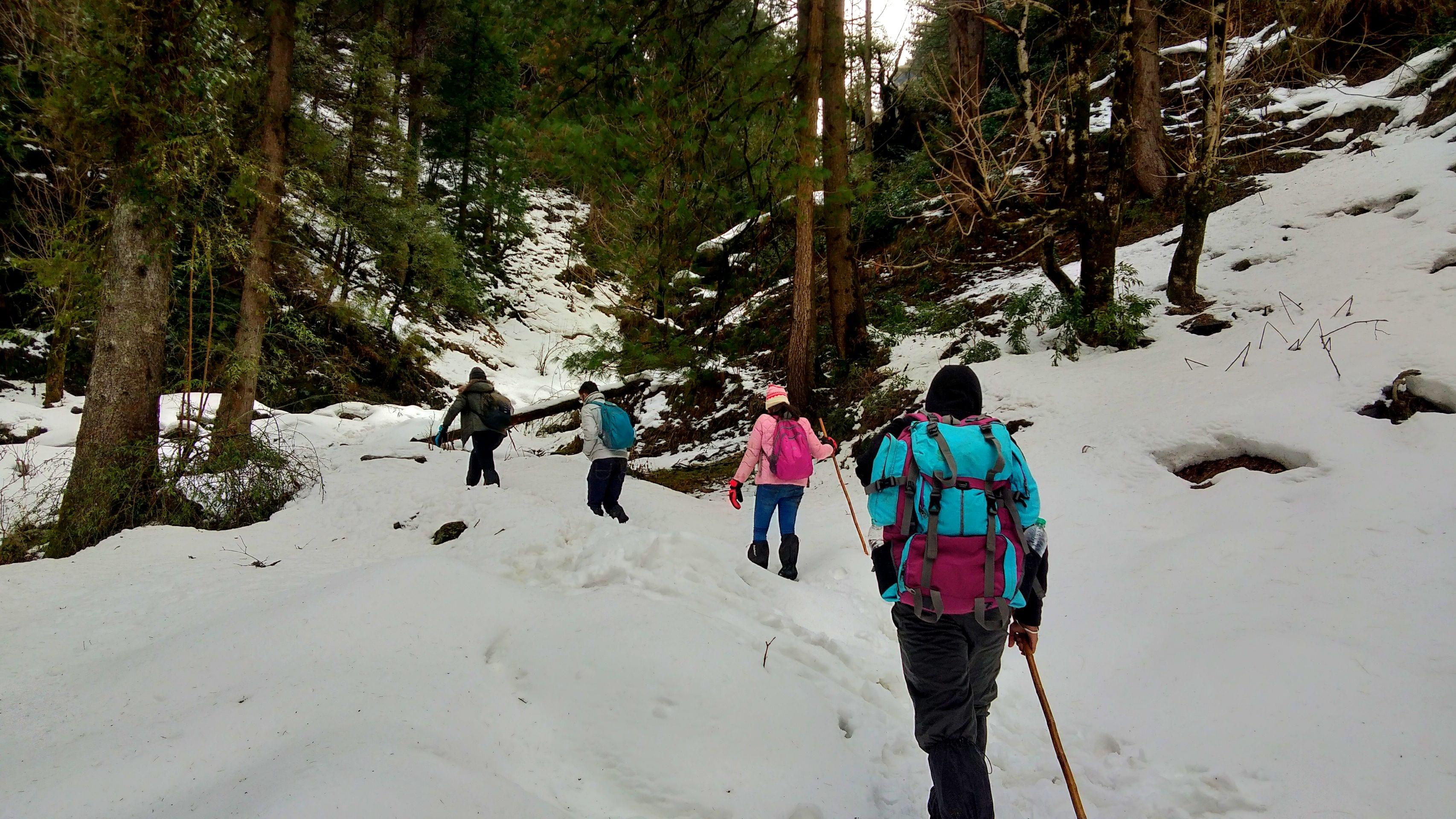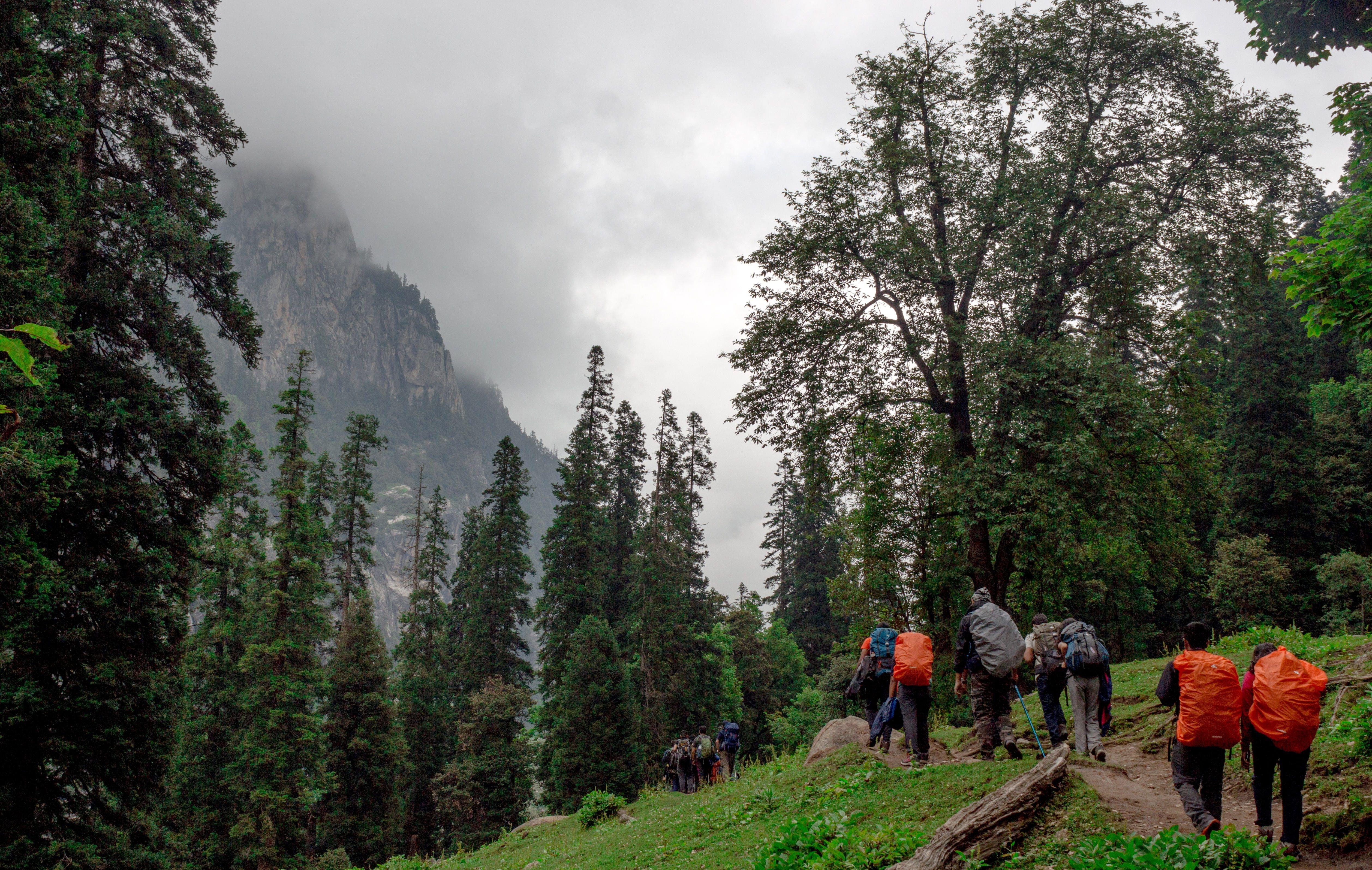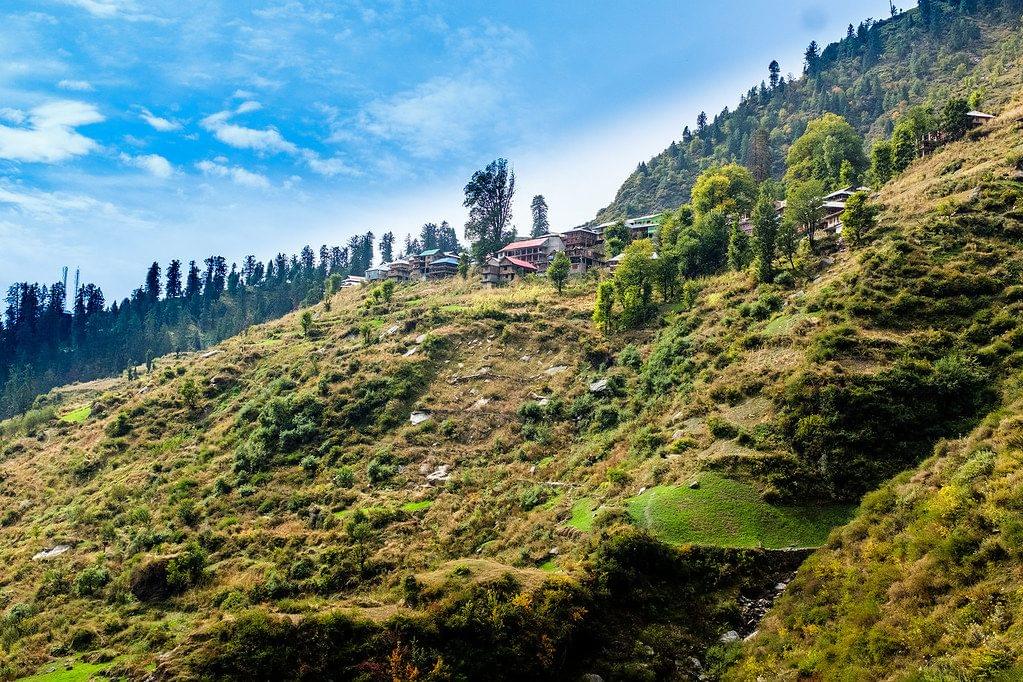Nag Tibba Trek Overview
Book Nag Tibba Trek Package
Quick Facts of Nag Tibba Trek
Maximum altitude: 9900 feet
Grade: Easy
Duration: 2 days
Trekking distance: 16 km
Trail type: Round trail (starts and ends at Pantwari village)
Rail head: Dehradun Railway Station is the nearest to the base camp.
Airport: Jolly Grant airport, Dehradun
Snow Season: From the months of December to March
Service from: Delhi to Delhi (Including transport)
Base camp: Pantwari
Best season: Winter (December to February), Summer (March to June), Autumn (September to November)
Region: Uttarakhand
Who can participate: Anyone above 5+ years of age
Nag Tibba Trek Itinerary
Dehradun - Pantwari; the trek begins
- Reach Dehradun in the morning from Delhi.
- Report at the ISBT/Prince Chowk Bus stop at Dehradun at 7:15am.
- Halt at Kempty falls while passing by Mussoorie for breakfast.
- Travel by the pristine landscapes of Nainbagh and reach Pantwari village. Freshen up and enjoy lunch at the hotel.
- Begin with the first leg of your Nag Tibba Trek to reach the Nag Tibba base camp.
- Once at the base camp, refresh yourself with some hot tea and a scrumptious dinner.
- Stay in camps for the night, amidst the mighty hills and the beautiful valleys, with several smaller hamlets spread across the ranges.
Nag Tibba Summit - Pantwari
- Wake up to a beautiful sunrise and have a scrumptious breakfast before heading to the Nag Tibba Summit.
- Begin your trek to the summit that is situated at an altitude of 3048 feet.
- Immerse yourself in the views of extensive Himalayan peaks such as the Swarga-Rohini, Bandar Poonch, Kedarnath, and Gangotri upon reaching the summit.
- Have a delicious lunch once the trek is completed.
- Trek down to the Pantwari village after lunch.
- Reach Dehradun by 10:00 pm.
- Board the overnight buses leaving for Delhi.
- Reach Delhi the next day with some great memories of the trek.
What to Pack for Nag Tibba Trek?
- Head torch in case you wander around at night or in forests wherein sunlight is unable to reach.
- Warm clothes, preferably three layer clothing, and synthetic clothes since they are easier to dry and two trek pants.
- Carry your toilet paper and wraps to maintain your personal hygiene comfortably throughout the trek.
- A backpack, with all your trek essentials and other stuff is a must apart from the trek inclusions. Make sure to carry as less as possible, to ensure the weight of the bag is light enough to carry while trekking.
- Extra pair of socks is a necessity since your socks might get wet in the snow or water.
- Carry your fleece jackets and thermals to tackle the cold according to how susceptible you are to lower temperatures.
- It is extremely advisable to carry hiking shoes since they not only help in climbing better, but also improves the grip along the trekking terrain.Sports shoes are absolutely not recommended for trekking.
- Carry a small quilt or a blanket since it might get chilly during camping at the base camp during the Nag Tibba Winter trek, especially at night.
- Carry a minimum of two thermal inners to ensure you don’t catch a cold due to the rising altitudes.
- Carry an extra pair of slippers/walking shoes to change into, after trekking.
- Other necessary essentials include a woollen cap, mittens, scarf, rainwear, cutlery and a raincover for your backpack.
Know Before You Go to Nag Tibba Trek
There are a total of 3 trekking routes to Nag Tibba summit:
Trek Route 1: From Devalsari Village Distance: 13 kmsFrom the village Devalsari, the trek route goes through dense deodar forests and reaches a remote place, from where the Nag Tibba summit is 3 kilometres of climb. You can choose to stay in the Forest Guest House after taking the due permission from the Mussoorie Forest Office.
Trek Route 2: From Pantwari Village Distance: 8 kmsThis is one of the most popular trek routes to reach the Nag Tibba Base camp and summit. Located at a distance of 85 kilometres from Dehradun and 50 kilometres from Mussoorie, this route is the shortest amongst other the three trekking routes.
Trek Route 3: From Aunter (via Thatyur)For all the bike lovers out there, this route is motorable and goes via Thatyur until a bridle path near Aunter. Thereafter, you can walk up to the ridge top to Aunter. From this point onwards, the trekking route is quite simple with a few slopes.
The Nag Tibba Trek is a perfect weekend getaway and is also a comfortable trek for beginners out there.
It is strongly recommended to follow a certified, experienced guide during the Nag Tibba Winter trek.
It is advisable to check with the local authorities, or guides and tour operators about the weather conditions and roads, specially during the monsoon and post monsoon seasons while booking your Nag Tibba trek package.
Withdraw cash beforehand since there is no ATM facility from Pantwari upto the base camp and summit. The nearest ATM service is in Mussoorie, however, it is recommended to use ATMs in Dehradun since Mussoorie is usually crowded.
Basic Gear
Backpack & Rain CoverDay pack + rain coverWalking stick Hydration pack/water bottlePersonal Medical KitSnacks (Glucose, energy bars)
Clothes
T shirts (at least 3)Fleece T shirt (1)Fleece jacket/ Woollen SweaterWInd and Waterproof Jacket and PantExtra pair of Inners and socksTrek PantsWaterproof glovesFleece/woollen glovesPoncho
Personal Utilities
Sunscreen creamHand sanitizerToothbrush & toothpasteToilet Paper & wipesMoisturiserAntibacterial powderLip balm/ ChapstickQuick dry towel
Head Gears
Head torchSun capWoollen CapSunglasses/Glares
Foot Gears
Trekking ShoesClimbing BootsFloaters/SlippersCotton socksWoollen socksGaiters
Via flight/train
If you are planning your visit from any cities such as Bangalore, Mumbai, Chennai, Hyderabad or Pune, book your flight tickets a day prior to the Day 1 that is marked on the itinerary of the Nag Tibba trek.
Fly Directly to Dehradun
To have an additional day of rest and preparation, fly to Dehradun, which is well connected by most metro cities. The Dehradun airport is a bit far from the main city, although prepaid taxis are available at the airport.You can also walk up to 1.5 kms to the Dehradun-Rishikesh national highway, from the airport terminal. From there, you can take a bus to ISBT Dehradun. After you reach the ISBT Dehradun, you can catch a shared auto to the Dehradun Railway Station.
Fly to Delhi
This option is a lot more accessible than flying to Dehradun since it is well connected to several bus routes, airlines and railways. Ensure that your flight reaches Delhi by 8pm, on Day Zero. From Delhi, board the Nanda Devi Express (12401), which leaves from Hazrat Nizzaumdin station and reaches Dehradun at in the morning.
You can also catch regular buses from ISBT Kashmiri Gate to Dehradun. The buses run frequently and take about 7-8 hours to get to Dehradun from Delhi.
Once in Dehradun, the transportation arranged will take you up to the Pantwari village, from where the trek to Nag Tibba will begin.
Post - Monsoon Season
One of the best times to trek to the Nag Tibba summit is during the post monsoon season, between the months of September and November. Since there is less haze, the skies are clearer and the trek landscape appears to be raw and natural .
However, if you are looking for a snow-filled experience, the best time to go on the Nag Tibba Trek is during the months of December, January and february. The amount of snow, then is just right to enjoy the beautiful landscapes and camp.
Nearby Attractions
A popular tourist destination and a great picnic spot for families and wanderers alike, the Kempty Falls in Mussoorie is one of the best places to visit near the Nag Tibba. Present for 150 years, this place also hosts small restaurants and cafes, serving some delicious food.
An offbeat destination and a lost hamlet- Kanatal is one of the most picturesque places near Nag Tibba Trek. At a height of 8500 feet, this hill station is perfect for travellers looking for a quiet getaway. Kanatal is covered with lush green coniferous trees and is a must visit during winters.
For beautiful sunrise and magnificent sunset views, Lal Tibba, one of the highest peaks in Mussoorie, is an ideal place to visit. You can even capture some beautiful snaps of winding mountain roads visible from the top of Lal Tibba on a clear day.
Located in Uttarakhand’s Tehri district, 12 kms away from the Pantwari village, Nainbagh lies at the intersection of Uttarkashi, Tehri and Dehradun. It serves as an ideal base spot for camping before beginning the Nag Tibba Trek.
Owing to its pristine landscapes and beautiful panoramic views of the Himalayas, this tinsel town is a trekkers paradise. Sitting at a height of 2286 metres above the sea level, Dhanaulti is one of the must visit destinations.
Why to Go Nag Tibba Trek?
You May Also Like
FAQ's of Nag Tibba Trek
What is the best time to visit Nag Tibba trek?
The best time to visit Nag Tibba trek is during the winter season, in between the months of December to February. Though Nag Tibba trek is an all-season trek, the snow-filled mountains during the winter make it even more fun.
What is the height of Nag Tibba trek?
Perched at an altitude of 9905 feet from the ground and known as the highest summit point of the Garhwal Himalayas, the Nag Tibba trek offers mesmerising views such as Kedarnath and Gangotri from the top.
What are the activities included in the Nag Tibba trek?
The two main activities included in the Nag Tibba trek Package are hiking and camping. You can also indulge in exploring the mesmerising views you will encounter on this trek. Moreover, along with camping, meals and other activities such as bonfires are also included, making it a memorable experience.
What is the location of Nag Tibba trek?
Located at a height of 3050 metres in Garhwal Region of Lower Himalayas, the Nag Tibba trek is located 50 kilometres and about 80 kilometres from Mussoorie and Dehradun, respectively.
What is the difficulty level of Nag Tibba trek?
The Nag Tibba trek is moderately difficult, with a major part of the terrain being easily scalable except for the slope at the summit which might be a bit tough to hike through.
What is the length of Nag Tibba trek?
The entire length of the Nag Tibba trek is about 16 kilometres in total. It should take about 7-8 hours of trekking time to reach the summit.
Can I find snow at Nag Tibba?
You can find an abundance of snow in Nag Tibba and its surroundings during the winter months. The temperatures usually drop to about -2 to 5 degrees celsius during this time.
Is it possible to do the Nag Tibba trek in winters?
Yes, Nag Tibba Trek is one of the few Himalayan treks which is available during the winters owing to heavy snowfall in other popular trekking regions. In fact, winter is one of the best times since the snow does not hinder the trekking path and also blesses you with some incredible views.
Is it possible to experience snow during the month of March in the Nag Tibba trek?
Largely depending on the weather conditions during the month of March, you can expect to witness a little snow towards the summit of the Nag Tibba trek.
.png?w=auto&h=400)










